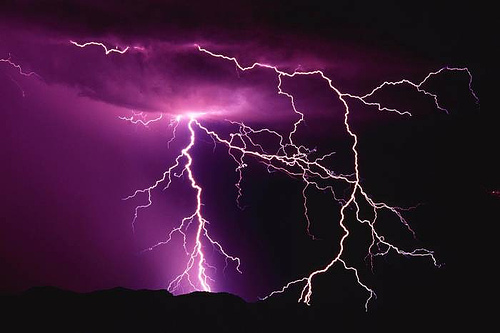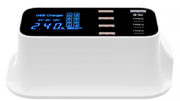In a word, yes! Any outdoor device made of metal that attaches to your home should be grounded. Cell signal booster antennas have many metal components, both in the antenna itself and the supporting brackets. If the antenna isn’t grounded, these metallic elements are a magnet for lightning during storms. Many homes have burned to the ground when this happens. The biggest danger is a lightning strike at night, when most people are sleeping. Grounding helps eliminate the risk of this happening, but that’s not all you need to do to protect your home and the people inside of it.
Antenna Grounding: What it Is
Most people have a vague understanding of what grounding is, but many might struggle if asked to define it. When discussing grounding cell signal booster antennas, the term “grounding” means something specific. It refers to attaching a metal device to an antenna’s mast and terminating it into the ground. If lighting should strike your antenna or mast, the grounding device leads the charge down a return path into the earth. This grounding or “earthing” helps prevent the lightning strike from having nowhere to go but into your home. This can short out your electronics and quite literally burn your house to the ground!
Which Antenna Should be Grounded?
Cell phone boosters have two antennas: an indoor and an outdoor antenna. The outdoor antenna accesses voice and 3G, 4G, and LTE data signal, then delivers it to the booster. The booster receives the signal, amplifies it, then sends it to the indoor antenna. That indoor antenna broadcasts the boosted signal through your home. This process works in reverse simultaneously each time you make a call or send data.
Now that you know how cell phone boosters work, which antenna do you need to ground? The answer is easy: you need to ground the outdoor antenna because it’s the one that’s exposed to potential lightning strikes. If you grounded the indoor antenna, you’d cause interference in the booster’s operation. For example, the low buzzing sound you hear from audio systems is due to indoor grounding. You don’t want this with your cell booster.
Grounding a Cell Signal Booster Antenna
When it’s time to protect your cell phone booster antenna from lightning, there are two things you need to do. First, you have to install an in-line lightning surge protector, then you must ground the antenna mast. Let’s take a closer look at each of these steps to protect your home and the devices and people inside of it.
1. Installing a Surge Protector: The first thing you have to do is get the right surge protection device. The impedance rating of your booster must match that of the surge protector. For example, boosters with F-type connections have an impedance rating of 75 Ohms, while boosters with N-type or SMA connections have a 50 Ohm rating. Make sure you get the right one for your booster’s antenna, and install it outside your home near the point of entry to reduce fire hazards.
2. Grounding Your Antenna Mast: Antenna masts are a prime target for lightning strikes because of their height and ability to gather static electricity. Grounding this mast requires a cable typically made of 10 AWG or lower gauge. Stranded cable is also good because it’s flexible. Just remember not to create any sharp bends in the cable during installation.
Here are the best ways to connect your grounding cable:
-
A ground rod, which is s simple metal rod buried into the ground.
-
The metal electrical service panel that’s usually connected to the ground rod.
-
The metal electrical raceway or conduit. Just attach a grounding strap to it.
-
A water pipe that’s in direct contact with the earth. Only do this if the pipe if you attach it within five feet of the water pipe’s entrance to your home, and if the pipe is at least 10 feet above the earth before entering your property.
-
The metal frame or structure of your home. Use this if no other options are available.
Before you do any of this, we highly recommend you take this extremely important step…
… Check Your Local Ordinances!
As disclaimers go, this is a very big one. Grounding rules are different from city to city. While we’re happy to offer tips for grounding your cell phone signal booster antenna, we don’t know where you live or what your local ordinances say about it. Before you do anything, we highly recommend you go to your local city hall or office to get the specific rules for grounding antennas. You can also consult an electrician who’s familiar with your area’s ordinances to help you. It’s very important!
Solid Signal is Here to Help!
Full disclosure: we make installing surge protectors and grounding antenna masts sound easy. Full disclosure: I wouldn’t try this without checking and double-checking Solid Signal’s blog posts and white paper about grounding. Even after all of that, I would call to Stuart Sweet. (He loves it when I bug him on the weekends.) Stuart is a stickler for details, and he’ll be the first person to say, “Were you in a hurry when you read that? Because there’s something you’re missing.” The things he catches often mean the difference between a successful installation and total disaster. So yes, I’m thankful for his help… even when he chastises me.
Now I know that you can’t call Stuart with your installation questions. You can do have the next best thing, which is to use the Support from Solid Signal Facebook group. This forum lets you post your questions and get answers directly from our in-house expert, Mr. Stuart Sweet himself. And if you have a question about surge protectors and grounding wires, you can call our tech team at 888-233-7563. We’ll make sure you get the right products to help you ground your cell signal booster antenna and more.





